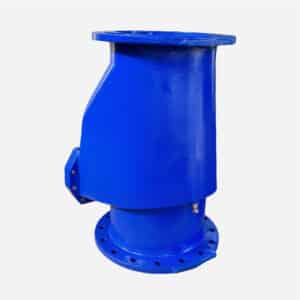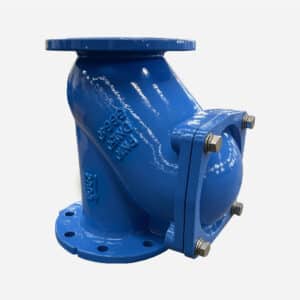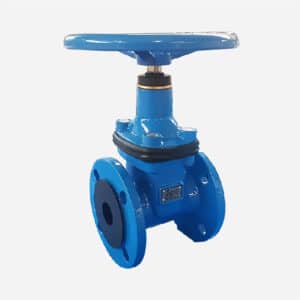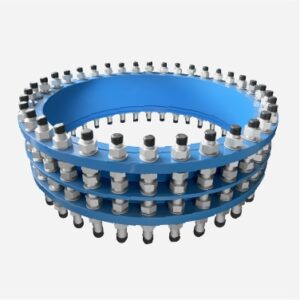Silent check valve is a specially designed check valve used primarily to prevent the reverse flow of liquid or gas in a pipeline. Its main function is to prevent the medium from flowing back and ensure that the fluid can only flow in one direction, thereby protecting the pipeline system from the effects of backflow.
At the same time, the silent check valve design reduces water hammer and noise when closed, providing a quieter operating environment.
Judberd is a professional manufacturer in china for silent check valve(also known as non slam check valve ),our silent check valve is as below.
FEATURE
● Flange ends
● Design Standard: BS EN12334
● Flanges Standard: BS EN 1092-2
● Inspection & testing: BS EN 12266-1
● Working Pressure: 16bar
● Working Temperature: -20℃ To 100℃

PARTS

BODY
The body is the main structural part of the silent check valve, responsible for containing and supporting all internal components. It ensures the stability and seal of the valve by connecting to the pipeline. The design and material selection of the body will affect the durability and corrosion resistance of the valve.
DISC
The disc is a critical part of the silent check valve, controlling the flow of fluid. It opens when the fluid flows in the correct direction and closes when the fluid flows in reverse to prevent backflow. The design of the disc of the silent check valve is typically to reduce water hammer and noise.
SEAL
The seal ensures a good seal between the disc and the body when closed to prevent fluid leakage. It is usually made of an elastic material such as rubber or polyurethane to provide effective sealing performance.
SPRING
In some silent check valves, a spring is used to help the disc close smoothly, reducing water hammer. The design and tension of the spring can control the closing speed of the disc to ensure the smooth operation of the valve.
GUIDE
The guide helps the disc to remain properly aligned during closing and opening to reduce wear and improve the operational stability of the valve. It is typically some guide slots or guide columns that are built into the body.
GUIDING STEM
The guiding stem helps the disc maintain the correct path during movement, preventing it from deviating from the normal working track. It is typically fixed internally in the body and connected to the disc to ensure the smooth movement of the disc.
The precise design and coordination of these structural components allow silent check valves to prevent backflow while minimizing noise and vibration,
enhancing the overall operational efficiency and comfort of the system.
WORKING PRINCIPLE
The working principle of a silent check valve involves the precise coordination of multiple components to prevent fluid backflow and minimize noise.
Here is a detailed description of the function of each component and how they work together:
FLUID ENTERS THE VALVE
When fluid flows in the forward direction into the silent check valve, it first passes through the inlet section of the valve body.
DISC OPENS
DISC
_
The disc is pushed open by the pressure of the fluid flow, allowing the fluid to flow forward through the valve. The design of the disc is typically to reduce resistance to fluid flow while avoiding generating excessive noise.
GUIDING STEM AND GUIDE
_
The guiding stem and guide ensure the disc remains in the correct position and path when open to prevent deviation and to allow the fluid to flow smoothly.
PREVENTS BACKFLOW
When fluid flow stops or changes direction, the silent check valve begins to close to prevent backflow.
SPRING (IF USED)
_
The spring provides the necessary push force during the closing process to enable the disc to close smoothly and quickly. The design of the spring helps control the closing speed to reduce water hammer and noise.
SEAL
_
The seal ensures the disc closely fits the sealing surface inside the body when closed to prevent any fluid from leaking through the seal gap.
REDUCES NOISE
DISC
_
The design and material selection of the disc, such as using elastic materials, help reduce impact noise when the disc closes.
SPRING
_
The elastic design of the spring can control the closing speed of the disc to prevent noise caused by rapid closing.
GUIDING STEM AND GUIDE
_
These structures maintain the smooth movement of the disc, reducing vibration and noise that may occur during closing.
INTERACTION BETWEEN COMPONENTS
DISC AND GUIDING STEM
_
The guiding stem ensures the disc moves along the correct path during opening and closing to reduce wear and deviation.The coordination between the guiding stem and the disc allows the disc to move smoothly to reduce noise.
DISC AND SEAL
_
The seal makes contact with the disc when it closes, forming a sealed interface to prevent fluid backflow.The elasticity and material selection of the seal determine the sealing effect and durability.
DISC AND SPRING
_
The spring provides a smooth closing force to the disc, avoiding water hammer and noise caused by sudden closing.The tension and stiffness design of the spring determine the closing speed of the disc and the noise control effect.
BODY AND OTHER COMPONENTS
_
The inner surface design and dimensions of the body must match precisely with the disc to ensure sealing and smooth fluid flow.The design inside the guide structure ensures that the disc remains stable throughout the entire working process.Through the precise coordination of these components, the silent check valve effectively prevents fluid backflow while minimizing noise.
APPLICATION
WATER SUPPLY SYSTEMS
_
In high-rise buildings or long-distance water supply pipelines, the silent check valve can effectively prevent water hammer. Water hammer is caused by pressure fluctuations due to the sudden closing or opening of valves, which can damage pipelines and equipment. The design of the silent check valve allows it to close slowly, reducing the occurrence of water hammer.
PUMPING STATIONS
_
Using a silent check valve at the inlet and outlet of a pump can prevent backflow and protect pumps and other equipment from damage due to backflow. Its silent operation can help prevent noise pollution in the pumping station, improving the comfort of the operating environment.
HVAC SYSTE (heating, ventilation, and air conditioning systems)
_
Using a silent check valve in these systems can prevent fluid from flowing back in the system, ensuring the efficient operation of the system and preventing damage to equipment.
INDUSTRIAL PROCESS CONTROL
_
In certain precise industrial processes, silent fluid control and preventing backflow are crucial. The design of the silent check valve can provide smooth fluid control, reducing vibration and noise.
REASONS FOR CHOOSING A SILENT CHECK VALVE INSTEAD OF OTHER TYPES OF CHECK VALVES ARE AS FOLLOWS
SILENT OPERATION
_
A silent check valve operates with almost no noise, making it ideal for environments where noise pollution is a concern.
PREVENTS WATER HAMMER
_
Due to its slow closing characteristics, the silent check valve can significantly reduce or eliminate water hammer, protecting pipelines and equipment.
LOW PRESSURE DROP
_
The design of the silent check valve typically provides a lower pressure drop, improving system efficiency.
EASY MAINTENANCE
_
Due to its simple design and reliable performance, the silent check valve usually requires less maintenance.
These features make the silent check valve the preferred choice in applications where silent operation,
prevention of water hammer, low pressure drop, and high reliability are required.

STATIC PRESSURE
Zero leakage under static pressure is crucial for silent check valves, and here are the reasons why:
PREVENT BACKFLOW
_
The primary function of a silent check valve is to prevent fluid from flowing back. If there is a leak under static pressure, fluid could flow backwards, which would disrupt the normal operation of the system. For example, in a water supply system, backflow could introduce contaminants into clean water sources, posing a health risk.
PROTECT EQUIPMENT
_
Many systems have equipment that must have fluid flowing in a specific direction. For example, pumps in a pumping station can only work in one direction. If there is a leak under static pressure, the reverse flow of fluid could damage pumps or other equipment, increasing maintenance costs and downtime.
MAINTAIN SYSTEM PRESSURE
_
In many systems, maintaining a certain static pressure is critical to ensuring the system works properly. If a check valve leaks under static pressure, the system’s pressure could drop, affecting the efficiency and performance of the entire system. For example, a drop in pressure in an HVAC system could lead to reduced heating or cooling efficiency.
PREVENT WATER HAMMER
_
A leak under static pressure could cause water hammer. When fluid suddenly flows back and hits a closed valve or other obstruction, there is a high-pressure fluctuation that can seriously damage pipes and equipment.
ENERGY SAVINGS AND COST-EFFECTIVENESS
_
Leaks can lead to energy loss, increasing the operating costs of the system. In systems where static pressure must be maintained for extended periods, leaks could lead to pumps or compressors frequently starting up to maintain the required pressure, increasing energy consumption and wear on equipment.
THE DANGERS OF LEAKS UNDER STATIC PRESSURE
SYSTEM PERFORMANCE REDUCTION
_
Leaks can lead to unstable system pressure, affecting the overall performance of the system. For example, in a water supply system, insufficient pressure could lead to inadequate or uneven water supply, affecting user experience.
EQUIPMENT DAMAGE
_
Backflow caused by leaks could damage pumps, compressors, and other critical equipment, increasing maintenance and replacement costs.
SAFETY HAZARDS
_
Fluids in some systems, such as chemical plants, are corrosive or toxic. Leaks could lead to safety incidents, endangering the safety of personnel and the environment.
INCREASED ENERGY CONSUMPTION
_
To compensate for the pressure lost due to leaks, systems need more energy to maintain normal operations, increasing operating costs.
Therefore, ensuring zero leakage under static pressure for silent check valves is crucial to guaranteeing the efficient and safe operation of the system.
Choosing high-quality check valves and conducting regular maintenance and inspections can effectively prevent leakage issues.
AS A SILENT CHECK VALVE MANUFACTURER, HOW WE CONTROL OUR QUALITY FOR SILENT CHECK VALVE?
01
Every step must strictly follow ISO9001 quality control system.
02
Valves are inspected in strict accordance with EN12266
03
The latest equipment is used to check the raw materials, the dimensions of the valves, the quality of the coating, the pressure of the valves etc.
PAY ATTENTION
HYDROSTATIC SEALING TEST FOR SILENT CHECK VALVE IS NECESSARY







